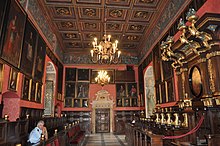Collegium Maius, Kraków
History
The then 36-year-old first university in Poland, known at the time as Akademia krakowska (English: the Krakow Academy), moved into the building some time in the 14th century after King Władysław II Jagiełło had purchased it as an educational grant with funds bequeathed by his late wife, Queen Jadwiga.
The Collegium Maius was rebuilt in the late 15th century as a late-Gothic structure surrounding a large courtyard bordered with arcades. In 1517 a well was built in the center of the courtyard. Professors lived and worked upstairs, while lectures were held downstairs.
In the 1490s the Collegium Maius counted among its students Nicolaus Copernicus, the Renaissance astronomer and polymath who would revolutionize European ideas about the universe.
Cultural significance
The Collegium Maius Museum features lecture rooms, communal halls, professors’ quarters, a library and a treasury containing rectors' Gothic maces and the Jagiellonian globe. Exhibits also include medieval scientific instruments, globes, paintings, collectibles, furniture, coins and medals.
Jagiellonian University Museum Directors
- Karol Estreicher (1951–1976)
- Stanisław Waltoś (1977–2011)
- Krzysztof Stopka (since 2012)
See also
References
- ^ Jagiellonian University (2016), Muzeum Uniwersytetu Jagiellońskiego Collegium Maius.




